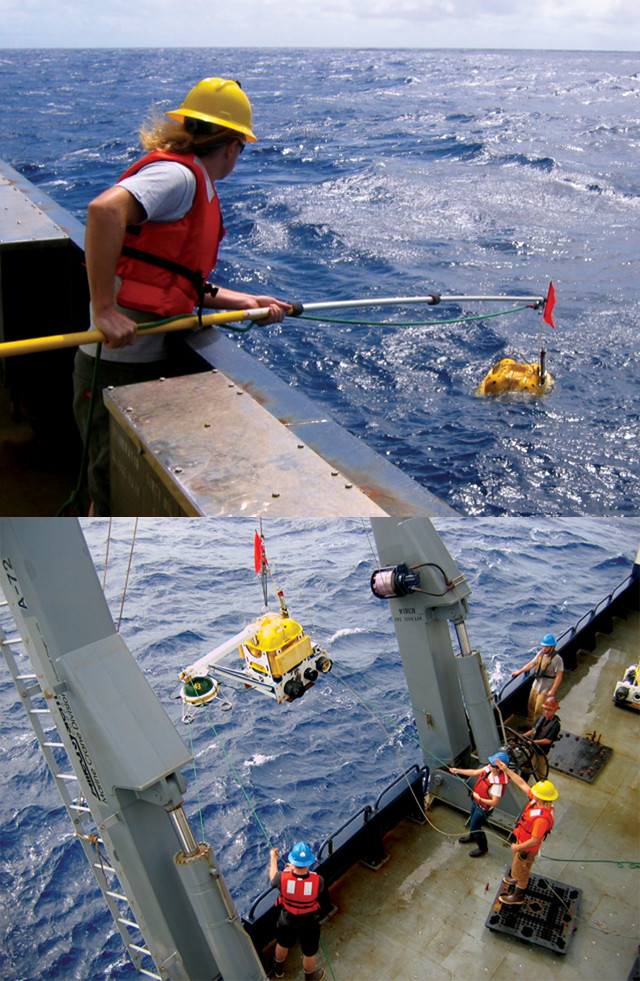
by Adityarup "Rup" Chakravorty Tuesday, November 15, 2016

Deployment and recovery of an ocean-bottom seismometer (OBS) from the R/V Langseth in the Pacific Ocean more than 1,900 kilometers southeast of Hawaii. The OBS was lowered into the water via crane, where it then fell to the seafloor under its own weight. It stayed on the seafloor for 13 months; researchers then returned to the location, sent the instrument a message to disconnect from its anchor weight, and it rose to the surface where researchers scooped it up. Credit: both: James Gaherty.
In December 2011, scientists and technicians aboard the research vessel Marcus G. Langseth dropped several ocean-bottom seismometers into the deep Pacific more than 1,900 kilometers southeast of Hawaii to measure seismic activity and electrical conductivity to a depth of about 300 kilometers below the seafloor. Now, these measurements are providing new insights into how the mantle flows and deforms below the rigid tectonic plates that make up Earth’s surface.
“Most people’s expectation — including ours — was that the motion of the tectonic plates over the underlying mantle would dominate how the mantle flows,” says James Gaherty, a geophysicist at Columbia University’s Lamont-Doherty Earth Observatory and a co-author of a new Nature study reporting the measurements. For example, at the study site, the researchers expected that mantle flow would be heavily influenced by the movement of the Pacific Plate above it.
Gaherty and his colleagues deployed more than 50 ocean-bottom seismometers, some of which recorded the seismic output of shallow-source earthquakes from around the Pacific Basin for more than a year. They also used instruments to measure the electric and magnetic fields on the seafloor. The combination of information from these devices allowed the researchers to create a high-resolution picture of how the crust and mantle in the study area were moving.
Unlike continental crust, the crust that underlies the oceans is only about 5 to 10 kilometers thick. Below this is the uppermost, solidified part of the mantle, which together with the crust makes up the lithosphere. The rigid portion of the mantle, which extends to depths of about 60 kilometers at the study site, showed a flow pattern that strongly correlated with how the crust in that area is moving.
But the researchers found that below depths of about 80 kilometers, a more pliable and viscous layer of the mantle called the asthenosphere is behaving quite differently. “We were surprised to discover that although the asthenosphere is very active, [flow dynamics] are not due to the plate-induced process,” Gaherty says. “Instead, [flow in the asthenosphere] is mostly independent of the larger-scale plate motion.”
The authors hypothesize that smaller-scale processes are behind the unexpected dynamics of asthenosphere flow that they observe. One possibility is pressure-driven flow: Differences in temperature across the asthenosphere produce pressure gradients that squeeze material and cause it to flow. A second possibility is localized mantle convection: Cooler, denser portions of the asthenosphere sink and are replaced by hotter material, causing a circular flow.
While more research is necessary to home in on the processes influencing asthenosphere flow, “this paper brings back attention to the smaller-scale dynamic phenomena that might be taking place under tectonic plates,” says Barbara Romanowicz, a geophysicist at the University of California, Berkeley, who was not involved in the study. “Also, because the study is based on local data, the resolution is higher than in studies that consider the entire ocean basin.”
To be able to generate the high-resolution data that allowed them to detect the small-scale processes at work, Gaherty and colleagues had to choose the study site carefully. “To image the natural, background state of plate formation and mantle dynamics, we needed to avoid regions of complexity that are often the targets of geological studies — hot spots of volcanism, for example, or mid-ocean ridges,” Gaherty says. “We picked a location of an oceanic plate with a relatively simple and known history.”
The implications of this study extend beyond the seafloor and the asthenosphere, according to Gaherty. “Our findings reinvigorate long-standing discussions about the nature and role of smaller-scale flow processes in controlling or modulating surface evolution, especially in the oceans,” Gaherty says. “Understanding these processes, under a variety of conditions, is critical for understanding faults and similar processes, including those that control earthquakes and volcanoes.”
© 2008-2021. All rights reserved. Any copying, redistribution or retransmission of any of the contents of this service without the expressed written permission of the American Geosciences Institute is expressly prohibited. Click here for all copyright requests.